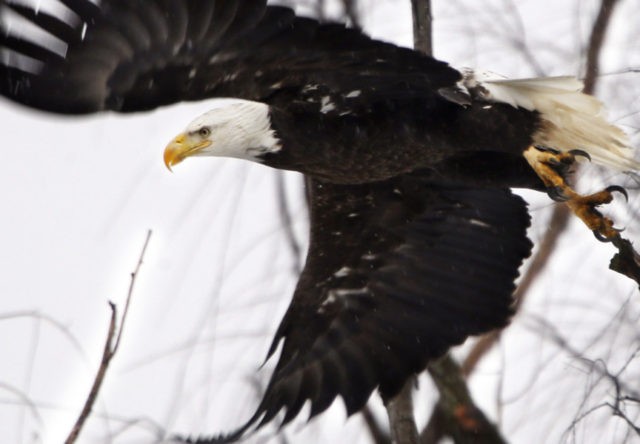WASHINGTON (AP) — The Trump administration on Monday rolled out some of the broadest changes in decades to enforcement of the landmark Endangered Species Act, allowing the government to put an economic cost on saving a species and other changes critics contend could speed extinction for some struggling plants and animals.
Interior Secretary David Bernhardt and other administration officials contend the changes improve efficiency of oversight , while protecting rare species.
“The best way to uphold the Endangered Species Act is to do everything we can to ensure it remains effective in achieving its ultimate goal — recovery of our rarest species,” he said in a statement. “An effectively administered Act ensures more resources can go where they will do the most good: on-the-ground conservation.”
Democratic lawmakers, several state attorneys generals and conservation groups said the overhaul would hamper protections for endangered and threatened species.
The Endangered Species Act is credited with helping save the bald eagle, California condor and scores of other animals and plants from extinction since President Richard Nixon signed it into law in 1973. The Endangered Species Act currently protects more than 1,600 species in the United States and its territories.
The changes included allowing economic cost to taken into account as the federal government weighs protecting a struggling species, although Congress has stipulated that economic costs not be a factor in deciding whether to protect an animal. That prohibition was meant to ensure that the logging industry, for example, would not be able to push to block protections for a forest-dwelling animal on economic grounds.
Gary Frazer, an assistant director at the U.S. Fish and Wildlife Service, told reporters that the government would adhere to that by disclosing the costs to the public, without being a factor for the officials considering the protections.
But Brett Hartl, a government affairs director for the Center for Biological Diversity conservation group, contended any such price tag would be inflated, and “an invitation for political interference” in the federal government’s decision whether to save a species.
“You have to be really naive and cynical and disingenuous to pretend” otherwise, Hartl said. “That’s the reason that Congress way back…prohibited the Service from doing that,” Hartl said. “It’s a science question: Is a species going extinct, yes or no?”
Other changes include ending blanket protections for species newly listed as threatened and a revision that conservation groups say could block officials from considering the impact on wildlife from climate change, a major and growing threat to many species.
“Nothing in here in my view is a radical change for how we have been consulting and listing species for the last decade or so,” Frazer said. Instead, he said, it brings “more transparency and certainty to the public about the way we’ll carry out our job.”
While the nearly half-century old act has been overwhelmingly successful in saving animals and plants that are listed as endangered, battles over some of the listings have been years-long and legend, pitting northern spotted owls, snail darters and other creatures and their protectors in court and political fights with industries , local opponents and others. Republican lawmakers have pushed for years to change the Endangered Species Act itself, in Congress.
Sen. John Barrasso, a Wyoming Republican who leads the Senate Environment and Public Works Committee, said Monday’s changes in enforcement to the act were “a good start,” but said he would continue working to change the act itself.
Democrats blasted the changes, and conservationists promised a court fight.
The regulations” take a wrecking ball to one of our oldest and most effective environmental laws, the Endangered Species Act,” Sen. Tom Udall, a New Mexico Democrat, said in a statement. “As we have seen time and time again, no environmental protection – no matter how effective or popular – is safe from this administration.”
At least 10 attorneys general joined conservation groups in protesting an early draft of the changes, saying they put more wildlife at greater risk of extinction.
“This effort to gut protections for endangered and threatened species has the same two features of most Trump administration actions: it’s a gift to industry, and it’s illegal. We’ll see the Trump administration in court about it,” Drew Caputo, a vice president of litigation for the conservation advocacy group Earthjustice.
A United Nations report warned in May that more than 1 million plants and animals globally face extinction, some within decades, owning to human development, climate change and other threats. The report called the rate of species loss a record.
In Washington state, Ray Entz, wildlife director for the Kalispel tribe, spoke of losing the struggle to save the last wild mountain caribou in the lower 48 states, despite the creature’s three decades on the Endangered Species List. With logging and other human activities and predators driving down the numbers of the south Selkirk caribou, Canadian officials captured and penned the last surviving members of the species over the winter and pinned them up for their protection.
“There were some tears shed,” Entz said, of the moment when tribal officials realized the animal had dwindled in the wild past the point of saving. “It was a tough pill to swallow.”
Despite the disappearance of the protected caribou species from the contiguous United States, Entz said, “We don’t want to see a weakening of the law.”
“There’s times where hope is something you don’t even want to talk about,” he said. But, “having the Endangered Species Act gives us the opportunity to participate in that recovery.”

COMMENTS
Please let us know if you're having issues with commenting.